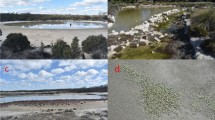Abstract
In the Shigenobu River Estuary (33 ° 48′ 18″ N, 132 ° 41′ 10″ E), Matsuyama (Japan), Helice tridens inhabits the mid-intertidal zone to the limit of the high tide, while H. japonica is found around the mid-intertidal zone. In addition, H. japonica is distributed further downstream than H. tridens. These differences suggest that H. japonica has a lower salinity and desiccation tolerance than H. tridens. Laboratory experiments on salinity tolerance confirmed the higher tolerance of H. tridens compared to H. japonica. Helice tridens survived at least a week under fresh water conditions, whereas most of the H. japonica died. Helice tridens was shown to be more able to tolerate desiccation than H. japonica, through behavioral, not physiological, adaptation to dry conditions. The present results demonstrate a stronger adaptation of H. tridens to semi-terrestrial and/or freshwater environments than H. japonica.
Similar content being viewed by others
References
Beer, C. G., 1959. Notes on the behavior of two estuarine crab species. Trans. R. Soc. N.Z. 86: 197–203.
Bursell, E., 1957. Spiracular control of water loss in the tsetse fly. Proc. R. Ent. Soc. Lond. (A)32: 21–29.
Edney, E. B., 1961. The water and heat relationships of fiddler crabs (Uca spp.). Trans. R. Soc. S.A. 36: 71–91. Fielder, D. R. & M. B. Jones, 1979. Observations of feeding behavior in two New Zealand mud crabs (Helice crassa and Macrophthalmus hirtipes). Maui Ora 6: 41–46.
Griffin, D.J.G., 1971. The ecological distribution of grapsid and ocypodid shore crabs (Crustacea: Brachyura) in Tasmania. J. Anim. Ecol. 40: 597–621.
Hartnoll, R. G., 1965. Notes on the marine grapsid crabs of Jamaica. Proc. L. Soc. Lond. 176: 113–147.
Herreid, C. F., 1969. Water loss of crabs from different habitats. Comp. Biochem. Physiol. 28: 829–839.
Herreid, C. F. & C. Gifford, 1963. The burrow habitat of the land crab, Cardisoma guanhumi (Latreille). Ecology 44: 273–275.
Jones, M. B., 1981. Effect of temperature, season, and stage of life cycle on salinity tolerance of the estuarine crab Helice crassa Dana (Grapsidae). J. exp. mar. Biol. Ecol. 52: 271–278.
Jones, M. B. & M. J. Simons, 1982. Habitat preferences of two estuarine burrowing crabs Helice crassa Dana (Grapsidae) and Macrophthalmus hirtipes (Jaquinot) (Ocypodidae). J. exp. mar. Biol. Ecol. 56: 49–62.
Kinne, O., 1971. Salinity: animal-invertebrates. In O. Kinne (ed.), Marine Ecology, Vol. 1, Environmental Factors, Pt 2, Wiley-Interscience, London: 821–1083.
Kurihara, Y., K. Sekimoto & M. Miyata, 1989a. Wandering behaviour of the mud-crab Helice tridens related to evasion to cannibalism. Mar. Ecol. Prog. Ser. 49: 41–50.
Kurihara, Y., T. Hosoda & S. Takeda, 1989b. Factors affecting the burrowing behaviour of Helice tridens (Grapsidae) and Macrophthalmus japonicus (Ocypodidae) in an estuary of northern Japan. Mar. Biol. 101: 153–157.
Little, C., 1983. The colonization of land; origins and adaptation of terrestrial animals. Cambridge University Press, Cambridge. 290 pp.
Omori, K., K. Shiraishi & M. Hara, 1997. Life histories of sympatric mud-flat crabs, Helice japonica and H. tridens (Decapoda: Grapsidae), in a Japanese estuary. J. Crust. Biol. 17: 279–288.
Pellegrino, C. R., 1984. The role of desiccation pressure and surface area/volume relationship on seasonal zonation and size distribution of four intertidal decapod crustacea from New Zealand: implication for adaptation to land. Crustaceana 47: 251–268.
Sakai, T., 1976. Crabs of Japan and the adjacent seas. Kodansha Ltd., Tokyo. 773 pp.
Sakai, K. & K. Yatsuzuka, 1979. Notes on some Japanese and Chinese Helice with Helice (Helicana) n. subgen., including Helice (Helicana) japonica n. sp. (Crustacea: Decapoda). Senckenbergiana Biol. 60: 393–411.
Shiraishi, K., 1988. Comparative studies on life history traits of H. tridens and H. japonica (Decapoda; Grapsidae). Master thesis, Ehime University. 35 pp.
Warner, G. F., 1969. The occurrence and distribution of crabs in a Jamaican mangrove swamp. J. anim. Ecol. 38: 379–389.
Wilkens, J. L. & M. Fingerman, 1965. Heat tolerance and temperature relationships of the fiddler crab Uca pugilator, with reference to body coloration. Biol. Bull. 128: 133–141.
Author information
Authors and Affiliations
Corresponding author
Rights and permissions
About this article
Cite this article
Omori, K., Irawan, B. & Kikutani, Y. Studies on the salinity and desiccation tolerances of Helice tridens and Helice japonica (Decapoda: Grapsidae). Hydrobiologia 386, 27–36 (1998). https://doi.org/10.1023/A:1003461911201
Issue Date:
DOI: https://doi.org/10.1023/A:1003461911201




